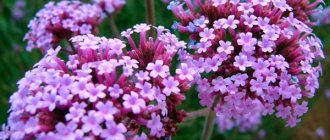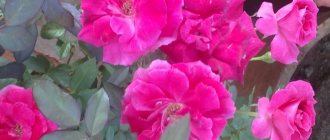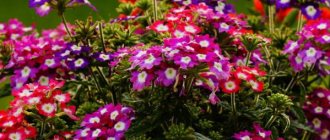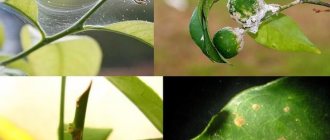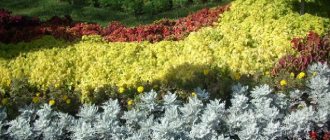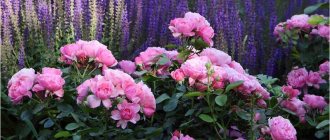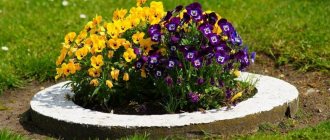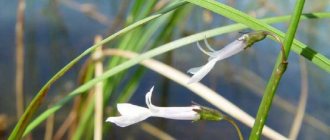general characteristics
Verbena belongs to the family of simple and unpretentious herbaceous plants of the same name. These can be small shrubs, a thick flowering carpet, or even tall, straight subshrubs up to several meters tall.
Verbena flowers are always small, up to a maximum of 2.5 cm, but at the same time they are collected in dense inflorescences and brushes. The color spectrum is wide and varied: from white and yellow to pink, dark red and even blue or dark blue.
Some varieties of verbena are actively used in medicine for the treatment and prevention of digestive problems. In cooking, it is often used for flavor in the preparation of preserves and preparations. Medicinal verbena is also in demand among beekeepers and honey lovers.
Photo: domashniecvety.ru
Choosing a landing site
Although verbena is considered an unpretentious plant, the planting site should be taken seriously.
Verbena loves sunlight, so for planting you should choose a well-lit area, the soil should be loose and fertilized. The plant is adapted to temperature changes, but does not tolerate frost.
History and use
Simple and unremarkable at first glance, verbena is a sacred plant. The name itself comes from the Latin “word”, because it was verbena that was used in oaths and spells.
The ancient Celts prepared a drink of love from this flower and created protective amulets against evil spirits. And according to Christian legend, it was this flower that grew at the foot of the cross of Christ on Golgotha, and it was used to stop bleeding in wounds.
Photo: pinterest.ru
Verbena was a symbol of Venus, and was carried in amulet even during battles with enemies. It was believed that it gives beauty and youth, and in children it develops abilities and memory. They believed that verbena brings and preserves prosperity and wealth in the home.
Verbena wreaths strengthened friendships and marriages, and its juice tempered iron for swords and daggers. Healers treated all illnesses with it, and washed their hair with its decoction for headaches and worries. Witches used verbena flowers for their spells and love potions.
Photo: qscaping.com
Columnar apple tree: varieties, care and cultivation (photo)
Outdoor care
An unpretentious plant still needs feeding, sufficient lighting, and loosening the soil. It is often said that Verbena “grows on its own,” like Gaillardia, but inattention to the needs of the decorative species has a negative impact on the greenery and inflorescences.
Watering
Warm, settled water is a prerequisite for good growing season and long flowering. The most abundant watering is from the beginning of summer to the end of July, then the amount of liquid is gradually reduced. Verbena is watered in the morning, before the sun rises high, or in the evening.
Feeding and fertilizer
Complex mineral compositions are applied during the active growth of green mass and the release of buds. The first fertilizing is carried out in early spring (optimally - organic fertilizers), then they switch to synthetic (granular and liquid) products.
Before applying any type of fertilizing, moisten the soil moderately. During the flowering season, the amount of nitrogen is reduced, more emphasis is placed on fertilizers with phosphorus (1/3) and potassium (2/3).
Care during and after flowering
It is useful to pick wilted buds from verbena in time to enhance the release of new elements. Fertilizing is carried out with an increase in the proportion of potassium and phosphorus so that flowering is long and abundant. Loosening and weed control are useful procedures that support the plant during flowering.
Be sure to water the verbena so that the soil is not too dry. It is useful to introduce effective and safe means to strengthen the vitality of plants. Succinic acid is a valuable product based on a natural component.
Bush formation
Rotten, limp, dried out and diseased shoots are removed: hygienic pruning is carried out. To form a lush bush during the growing season, cut off the top: this stimulates the growth of lateral stems. You cannot leave shoots that are too short: the decorative value of the bush is reduced.
Mulching, loosening
Simple but very effective procedures are useful for many reasons:
- loosening, as well as applying a layer of mulch on the site, retains moisture well after watering;
- If you loosen the soil in time, you can not only remove weeds after weeding, but also facilitate oxygen access to the roots.
Peat is most often used as mulch. It is important to chop the natural material and spread it in a thin layer within a radius of 20–30 cm under each bush. Mulch the soil after moistening. Peat is also a valuable fertilizer.
Types of verbena
There are more than 120 species of verbena in the world, but only a few of the most popular ones are cultivated and propagated at home. Most varieties are South American and grow everywhere from Chile to Canada. But some popular species have spread throughout Europe.
Pharmaceutical verbena
Verbena (medicinal) is the most popular and widespread species in our latitudes. This is a herbaceous perennial with a developed rhizome, which grows in height by 30-60 cm. Small flowers are collected in neat paniculate inflorescences, which begin to bloom in the axils of the leaves.
Photo: sadvokrug.ru
Hybrid verbena
Hybrid verbena is a whole group of selected garden varieties that were bred through long-term crossings of wild species. These are annual species that can be low-growing, large-flowered, or even ampelous. Height is from 20 to 70 cm, and long creeping shoots are good in flowerpots and decorative compositions.
Photo: lafa.ru
Verbena canada
This is one of the classic varieties - a low-growing garden shrub up to 20 cm tall. The bunched inflorescences look interesting, which distinguish this variety from the paniculate ones. The color is white, pink or purple, which contrasts favorably with the bright openwork leaves.
Photo: chrome-effect.ru
Lemon verbena
It is an aromatic perennial shrub that grows up to 2 meters in height. The branched stems are covered with bright green leaves, which, when crushed, emit a characteristic citrus aroma with light notes of lemon balm and mint.
Photo: grow-me.ru
Photo: funart.pro
Verbena tough
This is a variety with long creeping shoots, at the ends of which purple and blue buds bloom. Another interesting feature is the hard, toothed, elongated leaves. In its native Brazil, tuberous verbena is perennial, but in our latitudes it grows as an annual.
Photo: wellywoman.wordpress.com
Verbena Buenos Aires
The popular variety is known by many other names: tall, Brazilian, Argentine, lilac-flowered. In its native South America it is a wild perennial, but in our gardens it is grown as an ornamental annual.
This is a large variety with straight erect stems up to 1.5 meters, decorated with lilac umbrella inflorescences. Buenos Aires verbena looks impressive and, together with its jagged leaves, resembles openwork lace.
Photo: zakupator.com
General description of the flower
A typical description of a flower usually includes information that it is a perennial plant. In the middle zone it is often planted as an annual.
For decoration purposes, it is customary to use hybrid varieties of verbena. These are small bushes that usually grow no higher than 25 cm. Surrounded by a rosette of leaves, tall peduncles crowned with small flowers appear.
The bright color of the corollas attracts attention. The buds can be white, red, blue. Corymbose inflorescences look accentuated. The plant blooms in mid-summer and ends only in late autumn. Verbena can even withstand light frosts.
Verbena care
The undemanding verbena pleases gardeners with its unpretentiousness to conditions, so it is easy to manage in the garden. If you monitor watering, control the density of crops and avoid excessive amounts of moisture, there will be no problems with it.
Temperature
The ideal temperature for young shoots of verbena is above 20 degrees, and an adult plant feels comfortable even at +10. Abundant flowering will continue at 16-25 degrees, but short-term cooling does not affect the condition of the flower. The main thing is that it is returnable, because the flower does not overwinter in the open ground.
Photo: blogger.belhak.ru
Lighting
Verbena loves light, and the more the better, because with a lack of lighting, powdery mildew and other diseases can appear. The flower tolerates drought and heat better than lack of sun and high humidity.
Photo: provenwinnersdirect.com
Photo: 1zoom.ru
The soil
Verbena does not require special soil preparation or even regular loosening. Only with abundant watering in hot weather is it recommended to fluff up the soil for air circulation, otherwise the roots may begin to rot. And to avoid drying out, use mulch made from regular foliage or ready-made decorative mulch.
The soil for verbena is loose, permeable loam, so if the soil in the area is too heavy, add sand. And to protect the root system from moisture, lay a drainage layer of stones, expanded clay or brick fragments.
Photo: sadovyexpert.ru
Watering
The period of active flowering is the very time when verbena especially needs abundant and systematic watering. But by the second half of summer, be sure to reduce the frequency: verbena is resistant to short-term drought.
Photo: liveinternet.ru
Fertilizers and fertilizing
The ideal fertilizer for verbena is mineral fertilizers and special complex formulations. The easiest way is to immediately buy ready-made mixtures, but you can also use prepared organic matter. Apply fertilizer once a season and monitor the nitrogen level: if it is too high, the greenery will grow to the detriment of flowering.
Photo: znaysad.ru
Photo: pinterest.com
Trimming
Bushy verbena grows quickly and turns into a thick carpet, the density of which must be monitored during the first time after planting. And the main thing is to weed out the weeds, and then the flowering grass cover will delight you with beauty and neatness.
To make the plant bloom longer, remove the already faded buds: then they will not take up valuable resources. For decorative compositions, bushes can be shaped with ordinary garden shears.
Photo: pxhere.com
Blueberries: varieties, care and cultivation (photo)
Plant propagation
Since in our climate, in the vast majority of cases, verbena is grown as an annual, its propagation is carried out using seeds. The seeds have good germination, so they can be planted in open ground as soon as weather conditions allow. The main criterion is the absence of frost.
Planting seeds in a seedling box
In the case of a short summer, or if it is necessary to achieve early flowering, you can use the method of growing the plant using seedlings. The best time to sow seeds in this case is two months before planting the plant in the ground.
In temperate climates, the plant is planted in the garden in May, therefore, the seedlings should be planted in mid-March. It is advisable to prepare the soil for seedlings yourself.
Its composition may be as follows:
- peat – 4 parts
- leaf soil - 2 parts
- sand – 1 part
Sometimes it is recommended to add half a glass of wood ash to 2-3 liters of soil. Young plants are more vulnerable to fungi, so it is recommended to keep the soil for half an hour in an oven at a temperature of at least 110°C before planting. An alternative option would be to treat the soil with some fungicide, for example, Fundazol.
Verbena seeds, although they have good germination, germinate very unevenly, the delay can reach several weeks. Therefore, before planting, it is advisable to treat them with some kind of growth stimulator.
Sowing is carried out on the surface of leveled and slightly compacted soil, onto which the seeds are evenly applied. There is no need to sprinkle them with a layer of soil; they can remain on the surface.
Verbena shoots
After this, the seeds are watered using a spray bottle. Seeds must constantly remain in conditions of high humidity, so the box with seedlings must be covered with plastic film or glass.
Seeds of most species do not need light to germinate; warmth is much more important for them. The optimal temperature is about +25°C, so it is recommended to place the box with seedlings near a radiator or other heating device.
Every day it is necessary to ventilate the improvised greenhouse and water it with a spray bottle. When the first shoots appear, the box is brought out into the light, and the temperature drops to +15-17°C.
Picking a plant
Picking is done after 2-3 pairs of leaves appear. The plant is planted either in a common box with a distance between seedlings of 5-6 cm, or in individual containers, for example, in peat pots. Immediately after picking, watering the young seedlings is mandatory.
After picking, the seedlings must be placed in a bright place with a maximum level of lighting. 1 week after picking, the seedlings must be fertilized with mineral fertilizers.
In this case, it is advisable to use specially sold sets of fertilizers, for example : Mivena, Master-argo, Clean Sheet, etc. The frequency of such fertilizing is from 1.5 to 2 weeks.
For ampelous varieties of verbena, it is advisable to pinch the plants after the appearance of the fourth pair of leaves.
1-2 weeks before planting the plant in open ground, it is necessary to carry out the procedure of hardening the seedlings. She is left outdoors every day for an hour longer than the previous day.
Planting and propagation of verbena
Verbena is planted directly from seeds or by cuttings, which are stored in the fall. Before frost sets in, dig up the bushes and move them to a cool room until spring. To make cuttings, cut off the tops of the shoots up to five pairs of leaves and cover the cut with charcoal.
A mixture of peat and sand is better suited for rooting, but even in it there is no need to bury the shoot too deeply. After 3 weeks, a sufficiently stable and powerful root system will form under the film for transplantation.
Photo: joinn.com
No special preparation is needed for the seeds, but when sowing they should not be buried in the soil: just spread over the surface. Within just a few days at 20 degrees and above, they begin to germinate, after which you need to move the container to a cool place.
Fresh sprouts are especially sensitive to moisture, so do not overdo it with watering. Seedlings ready for planting will delight you in about 2 weeks, but transplant them into the ground only in consistently warm weather.
Photo: mobilemusic.ru
Growing from seeds to seedlings
The optimal option for growing a spectacular look on the site and for decorating terraces, balconies, loggias. It is important to plant seedlings on time so that the sprouts do not become too elongated. Late sowing of seeds is wrong: seedlings do not have time to grow and strengthen sufficiently, adult plants will be weak, and flowering will be less abundant.
Deadlines
Suitable time for planting seeds in the ground: late March - early April. In February - the first ten days of March, daylight hours are too short for the seedlings to have time to grow by the time they are transplanted into the ground.
Seed preparation
Stratification is the process of hardening planting material. The procedure is simple:
- the seeds are laid out on a damp cloth, wrapped in an opaque plastic bag, and put into a compartment for storing vegetables (in the refrigerator);
- within three to five days, the planting material gets used to the cold;
- after stratification, the seeds are dried to avoid rotting;
- Now the grains are suitable for growing seedlings.
Soil and container
The soil should be nutritious, with a high percentage of humus, but loose. It is useful to add a little fine sand to the soil mixture from the flower shop.
Wooden boxes or containers are suitable for growing verbena seedlings. You can add a little expanded clay to the bottom for good drainage.
Landing
How to proceed:
- the prepared seeds are laid out at a distance of 3–4 cm from each other;
- you can sprinkle a thin layer (0.5 cm) of humus on top;
- the soil is sprayed, the container is covered with polyethylene or glass to maintain moisture in the mini-greenhouse;
- Until the seeds have sprouted, shelter above the ground is a must.
Seedling care
Helpful Tips:
- watering. Excess moisture interferes with the development of sprouts. The soil is moistened (sprayed) only when the top layer dries;
- lighting. The plant loves light, like many beautifully flowering species. The sprouts should be in a well-lit room, but “direct sun” on the sprouts is unacceptable;
- ventilation of the mini-greenhouse. At the seed germination stage, a mini-greenhouse is created. Every two days the space under the glass is ventilated and condensation is collected. A few days after the sprouts appear, the ventilation time is increased to 3–4 hours, increased to half a day, then the container is completely opened so that the sprouts do not become moldy;
- temperature. During the “black earth” period (waiting for germination), the indicators should be at a level of +18 to +20 degrees. In a cold room, with high humidity, under glass or cellophane, the seeds often rot. After 2–4 weeks, sprouts appear. After two or three days, the container is transferred to a cooler room: from +14 to +16 degrees, so that the seedlings gradually stretch out. It is important that a cool room has good lighting;
- topping. The procedure is carried out for the ampelous variety of verbena. At the stage of formation of 5 and 6 leaves, the tops of the sprouts are pinched to stimulate the growth of lateral elements and good branching of the bush. Verbena of other varieties is not pinched.
Transplanting
First, sprouts are planted into separate containers. The average time is a month after seed germination, when 2 young leaves appear. Suitable containers are cassettes or peat pots. It is important that the base contains a high percentage of peat and not cardboard, which is often added to cups by unscrupulous manufacturers
Pick up the seedlings carefully, making sure that the tender roots remain intact. After a couple of weeks, when the seedlings have taken root in the new container, low concentration mineral fertilizers are applied. Complex formulations are suitable for beautifully flowering species.
Important details:
- Verbena does not tolerate cold and frost well, so there is no need to rush to move mature sprouts to the site;
- some species can tolerate -2..-3 degrees, but prolonged exposure to low temperatures negatively affects even cold-resistant varieties;
- the soil and air should warm up to at least +14..+16 degrees. It is important that frost stops completely;
- On the site, be sure to dig up the substrate, break up all the clods, and carry out loosening;
- It is useful to add fertilizers and nutrients: ammonium nitrophosphate (50–60 g), humus (about a medium bucket) and a glass of wood ash. The norm is indicated for 1 sq. m;
- make small holes in the prepared soil into which the sprouts will fit along with the roots. It is useful to arrange a drainage layer (1 cm) of sand at the bottom of the hole;
- After planting, sprinkle the roots with substrate, compact them a little, and moderately water the area around each plant.
Choice of location and lighting
Verbena is unpretentious, grows well both on nutritious and light loams, and on heavy soil combined with sand to increase looseness. Swampiness is the enemy of a beautifully flowering species.
A bright place is ideal for placing verbena bushes. Even with a completely open area, without shade, pigeon grass grows well and blooms well.
It is important that there are no weeds in the planting area. Digging the soil in autumn and spring reduces the risk of pests and weeds breeding.
Pest and disease control
Unpretentious verbena rarely gets sick and is practically not interesting for garden pests. But if the conditions are violated, the soil is excessively moistened or weeding improperly, you can run into trouble.
The most common problem is powdery growth, which causes leaves to darken and die. If you find it, remove all damaged areas and spray the verbena with special fungicides. The same goes for rot: if the plant turns pale and withers, the first thing is to prevent the problem from spreading.
Among insects, aphids and leaf miners are sometimes found, which feed on leaves. But to combat them you do not need to undertake any complex manipulations: regular use of insecticides is enough.
Photo: dacha.today
Photo: mrfilin.com
Periwinkle (60 photos): varieties, care and cultivation
Planting seeds in open ground
In most cases, flower growers do not practice this method.
First you need to grow strong seedlings, and only then transplant the grown seedlings into the garden, into a flower bed or into a decorative box to decorate a balcony, loggia or terrace. Some varieties of verbena have a fairly dense skin on the surface of the seeds, and special preparation is not necessary. On a note! You shouldn’t experiment even in warm regions: it’s easier to grow healthy seedlings than to sow seeds right on the site and get weak bushes, poor flowering, or even be left without half the bushes: germination is not ideal.
Verbena – photo
The simplicity and unpretentiousness of verbena are combined with its neat and graceful beauty. Convince yourself of this thanks to the photographs in our gallery. Enjoy watching!
Photo: plants.tlcgarden.com
Photo: etovarikoz.ru
Photo: chrome-effect.ru
Photo: greenagri.ru
Photo: 2sotki.ru
Photo: artfile.ru
Photo: dvervleto.su
Photo: 1zoom.ru
Photo: vasily-sergeev.livejournal.com
Photo: liveinternet.ru
Photo: ludmila20141.livejournal.com
Photo: flormar-shop.ru
Photo: pxhere.com
Photo: plants.chaletnursery.com
Photo: ok.ru
Photo: dlobal.ru
Photo: stroypay.ru
Photo: tsvetovodovklub.ru
Photo: pixy.org
Photo: pixabay.com
Photo: avto.goodfon.com
Photo: dacha73.ru
Photo: 1zoom.ru
Photo: pinterest.ru
Photo: pixabay.com
Photo: pixabay.com
Photo: polemo.ru
Photo: greenway-schop.ru
Photo: lesserresdebutry.fr
Photo: landshaftadvice.ru
What does this beautiful herbaceous plant look like?
Depending on where it grows, verbena looks different : in a very warm climate, this perennial plant reaches 1.2 m, the trunk becomes lignified, it rather resembles a shrub, and often grows wild or in flower beds without replanting. But in temperate and cold climates it is an annual with short herbaceous branches that die off during the first frost.
Green or brown-green stems, depending on the species, can be:
- creeping (falling beautifully from the trunk or from the flowerpot);
- prostrate (forming a rosette from the main trunk);
- erect (stretch upward, creating a thick green mass);
- pubescent (small fluffy whitish threads cover the trunk);
- smooth.
The leaves of verbena are either narrow, whole, or dissected, or pinnately incised. There are many of them on a branch, arranged alternately (rarely - whorled, i.e. from each node there are 3-4 leaves), so even an annual plant gives the impression that a perennial shrub is growing. The edges of the leaves have small, non-sharp (in some varieties turning into an elongated oval shape) or sharp teeth.
Verbena flowers are amazing with their dim beauty! They are collected in inflorescences (from 20 to 50 pieces). A separate peduncle is a five-toothed calyx with a five-lobed corolla. Flowers may be collected in racemes, spikes, or paniculate inflorescences . And how beautiful their color scheme is:
- blue and light blue;
- pink and red;
- white and yellow;
- cream and purple.
And this diversity pleases from the beginning of June to the end of October.
Where can I buy it and for how much?
You can purchase verbena seeds or cuttings only in specialized stores . Basically, these are flower shops or for amateur gardeners. Seeds are sold in bags of 5-10 pieces. The price, depending on the variety and number of seeds, ranges from 15 to 650 rubles (seed germination is low - no more than 30%, so before purchasing a particular variety of verbena, you need to consult a specialist about the peculiarities of cultivation).
The most expensive seeds are hybrid varieties from Europe: Amsterdam and Paris. In addition, seeds of rare garden plants (this includes verbena) can also be purchased in time-tested online stores. For example, in AGROSERVER you can buy medicinal verbena for 30 rubles for a bag containing 50 seeds, and in “Seeds Here” you can buy different types of flowering varieties of this plant from 15 to 21 rubles per bag.
Diseases
Hybrid verbena, like other varieties, is little susceptible to disease. But it can also be attacked by fungi and insects.
Powdery mildew
The fungus sets in high humidity amid warm weather. White blotches appear on the leaves, similar to spilled flour. Severe infestation causes their color to change to purple. Then the leaves fall off and the plant dies. The disease is treated with fungicides containing copper (Oxychom, Abiga-Pik, copper sulfate) and new combined systemic drugs (Vitaros, Ridomil Gold, Previkur).
Rotten
Verbena bushes can be attacked by almost any fungal rot. Among them are stem, black leg, root, gray. By cutting off all the affected parts in time and treating healthy tissues with fungicidal agents, you can save your flowers from the disease.
There are different types of verbena: finely cut, ampelous, medicinal, Buenos Aires. You can read about them on our website. We have also prepared information about the beneficial properties, uses and contraindications of medicinal verbena.
Landscape design
Due to the variety of varieties, verbena is often used in garden design. It goes well with almost all types of flowers and serves as a real garden decoration.
Verbena can be grown either separately or as part of mixed flower beds, as well as for edging borders and fences. Low-growing varieties look great in flowerpots and flowerpots, and ampelous varieties form a spectacular color cascade.
What is the scent like?
The plant is capable of producing amazing aromas . What does the smell of verbena flowers smell like? Even in ancient times, it was believed that its smell could evoke love, and therefore love elixirs and wreaths for brides were made from it. If a woman wanted to win the heart of her chosen one, she must use oils based on the “herb of Venus.”
In addition, it is believed that this plant prolongs youth thanks to the fragrant essential oils included in its composition, polyphenols - antioxidants that protect the skin from aging. Therefore, verbena oil, as soon as perfumes for body and face care appeared, was added to soap. The smell of the “witch’s herb” has always helped a person to calm down after a busy day; it is not for nothing that it is called “the herb of good dreams and health” (read more about the medicinal properties and use of verbena in folk medicine here).
In the form of herbal sachets under the pillow, this plant is used as a remedy for:
- nightmares;
- headache;
- with loss of strength;
- relieves migraines;
- normalizes blood pressure.
Modern aromatherapists believe that the smell of verbena can develop intuition and creativity in a person, so its place is in the children's room next to the bed or desk.
Today, more than 200 species of the fragrant plant, lemon verbena, are used in perfumery. It has a subtle scent, sweet, with notes of freshness and a lemon aroma. After thermal and oil treatment of this herb, faint fruity and floral notes necessarily appear, which make the aroma richer, brighter, more stable, and tastier. But there is a danger that the strong smell of lemon verbena will still extinguish the additional aroma!
In the creation of perfumes they are “friends” with verbena:
- roses;
- geraniums;
- nutmeg;
- cinnamon;
- anise;
- honeysuckle;
- wild apple tree;
- grapefruit;
- sandalwood;
- bergamot.
All components in cosmetics and perfumes benefit from the community of aromas, the smell becomes refined and unobtrusive.


